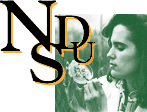 |
|
Page Layout Information
Page layout for the species accounts: Every page contains the following headings or portions: Running header label, Latin name, Common name, Hodges checklist number, Identification, Similar species, Distribution, Host, Pictures, and North Dakota map.
1. Running header label: Consisting of two parts, the Moths of North Dakota logo at top left which is a return the title page and moth higher classification on the right. The latter is informational but will, as the site develops, link the user with identification keys for each level listed.
2. Latin name: This is the species name. With this name a reader can access (through appropriate journals) all original research for each species. Simply using this name as the start of a web search will often yield much additional information.
3. Common name*: Included here only in deference to the current fad of christening uncommonly encountered species with a ‘familiar’ name. A great effort has been made to include the most widely used common names. In a very few cases, existing common names have been modified due to ambiguities with taxonomy. Where a ‘common name’ is coined, it is preceded by the phrase ‘listed here as’ on each page. All such names are placed in quotes in the species list.
4. Hodges’ checklist number: This is a reference to the Hodges et al. 1983, Checklist of the moths of America north of Mexico, as of this writing, the most recent listing of North American Lepidoptera. The number refers to the entry number of a given species in that checklist. Also under this heading can be found any taxonomic advancements resulting in changes in classification since the checklist. In cases where a species has been discovered or been introduced into North America since the publication of that list, the number given is that of the most closely related species, modified by the decimal addition of 0.1; i. e. Noctua pronuba is listed as #11012.1 to distinguish from the related American species Cryptocala acadiensis, #11012.
5. Identification: These are the features to ‘clinch’ a species identification. Species specific characters for differentiation from similar moths are given here along with characters not readily observed in the ‘habitus picture’ provided. Terms requiring the glossary will often be found here. The wingspan measurement given (in millimeters) is the length of the right forewing from base to apex of the specimen pictured.
6. Similar species: These are the checklist numbers (and hyperlinks) to pages illustrating those species most similar to the current one (in North Dakota). As pages are added to this site an attempt is being made to include all members of complexes of similar species simultaneously. For example, all three Feltia speciesi– dingy cutworm moths are illustrated (#’s 10670, 10674, 10676) or the three Hyles species– white lined sphingids (#’s 7892, 7893, 7894).
7. Distribution: Under this heading is a brief description of the species’ overall distribution.
8. Hosts: larval host plants (or very rarely, animals) are listed here. Where known hosts constitute an extensive list, this fact is noted rather than reciting a significant portion of the local plant community. Also, such lists are condensed to only those plants occurring in North Dakota. In cases where known host and known moth distributions strongly disagree, this fact is noted– See Tarachidia semiflava (#9085) for example.
9. Pictures: The habitus pictures should give an overall appearance of the species. Each picture has been checked against the original specimen for color accuracy. Where a species has well marked sexual, seasonal, or varietal differences, these are illustrated. Showing half a moth allows for a more detailed photograph within space limitations (rapid download/ file size). Under each picture is the collection data for the specimen illustrated.
10. North Dakota map: Known collection sites represented by specimens in the North Dakota State Insect Reference Collection, the author’s collection, other collections, or from reliable literature sources are plotted on this map in dark green. Such data as these are often not sufficient to indicate a species’ distribution in the state and for this reason, county records of host plants taken from Atlas of the Flora of the Great Plains (Great Plains Floral Association 1977) are indicated by pale green shading. This information is, in turn, augmented by the overall moth distributions given in the text. The resultant three sided approach (general range, county records, host plant county records) should give the reader a handle on the expected distribution of a given species in North Dakota.
*Over the past sixty years, and especially the last 20 years, there has been an impetus to create portable guides (often called pocket or field guides) to various groups of the fauna and flora of various regions of the world. The outstanding good these guides do is to provide accessibility to the natural world and, the following comments not withstanding, the amount of environmental awareness fostered by these guides is beneficial beyond measure.
There are however, two important deleterious side effects: 1) They create what I term ‘the field guide mentality’ which is the misconception that nature is simple and species can be identified by just finding the right pocket guide– Moths of North Dakota should provide a reality check on this ideal. Many important identification characters are not visible in a ‘guide habitus picture’ and many of these features can only be referred to using exact terminology. Some moths must be dissected to be identified with certainty. 2) They create a duplicate and artificial system of common names which are regionally based (eastern U.S. or Canada, or Mexico for example) and similarly linguistically restricted when a system of names already exists which is formulated in a single language, used worldwide for this specific purpose, and provides a key to universal information retrieval for all research ever done on any particular species. These two elements together, ‘field guide mentality’ and duplicate naming engender and encourage an already extant scientific illiteracy– the tip of a very large (and not melting) iceberg indeed.